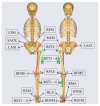Suitable Heel Height, a Potential Method for Musculoskeletal Problems during the Third Trimester: A Pilot Study
- PMID: 39061749
- PMCID: PMC11274345
- DOI: 10.3390/bioengineering11070667
Suitable Heel Height, a Potential Method for Musculoskeletal Problems during the Third Trimester: A Pilot Study
Abstract
Background: The treatment options for third-trimester musculoskeletal issues are limited. This study aims to examine how heel height affects gait biomechanics and provides heel height recommendations for various musculoskeletal problems.
Methods: Five third-trimester gravidas were recruited wearing uniform footwear with four heel heights (0 mm, 15 mm, 30 mm, and 45 mm). Lower-limb muscle forces, joint angles, joint torques, joint contact forces, and ground reaction forces (GRF) at specific moments (the first peak, valley, and second peak of GRF) were collected for one-way analysis of variance with repeated measures.
Results: The soleus, gastrocnemius, tibialis posterior, plantaris, obturator externus, gluteus maximus, gemellus superior, and obturator internus were the smallest at heel heights of 45 mm and 15 mm at the valley of GRF. Hip extension and knee flexion displayed the smallest joint angle and joint torques at a height of 15 mm. Ankle joint contact force decreased with increased heel height.
Conclusions: The height of the heel significantly impacts muscle force, joint angles, joint torques, and joint contact force. A heel of 15 mm might be the most suitable heel height to potentially avoid or alleviate musculoskeletal problems during the third trimester.
Keywords: gait biomechanics; heel height; third trimester.
Conflict of interest statement
The authors declare no conflicts of interest.
Figures







Similar articles
-
The Shank-to-Vertical-Angle as a parameter to evaluate tuning of Ankle-Foot Orthoses.Gait Posture. 2015 Sep;42(3):269-74. doi: 10.1016/j.gaitpost.2015.05.016. Epub 2015 May 27. Gait Posture. 2015. PMID: 26050873
-
The influence of heel height on utilized coefficient of friction during walking.Gait Posture. 2011 May;34(1):107-10. doi: 10.1016/j.gaitpost.2011.03.023. Epub 2011 May 4. Gait Posture. 2011. PMID: 21536444
-
Heel height affects lower extremity frontal plane joint moments during walking.Gait Posture. 2012 Mar;35(3):483-8. doi: 10.1016/j.gaitpost.2011.11.013. Epub 2011 Dec 12. Gait Posture. 2012. PMID: 22169388
-
Contributions to the understanding of gait control.Dan Med J. 2014 Apr;61(4):B4823. Dan Med J. 2014. PMID: 24814597 Review.
-
Foot strike alters ground reaction force and knee load when stepping down during ongoing walking.Gait Posture. 2020 Feb;76:327-333. doi: 10.1016/j.gaitpost.2019.12.019. Epub 2019 Dec 24. Gait Posture. 2020. PMID: 31896535 Review.
References
Grants and funding
LinkOut - more resources
Full Text Sources

